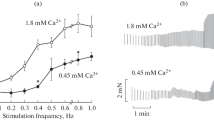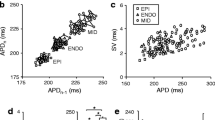Summary
Isolated perfused guinea pig hearts (Langendorff preparation) were arrested by carbachol (0.1–0.2 mg/l) and electrically stimulated in the region of the av-conducting system. The QT interval was determined by means of extracellular electrodes at different driving frequencies. Separate experiments were performed on papillary muscles from the right ventricle to measure the duration of the transmembrane action potential under comparable conditions.
At 35 °C (K +e 5.4 mmol/l) increasing the frequency of stimulation (range 12–120/min) caused the action potential duration (APD) to decrease to a greater extent than the QT interval. Stepwise rising of the external K+ concentration up to 16.2 mmol/l produced a nearly parallel shift of the APD-frequency relation to lower values. Again, the QT interval was less affected by increasing the external K+ concentration than the APD. Stepwise reduction of the temperature down to 20 °C prolonged the APD as well as the QT interval, the effects being more pronounced at lower than at higher stimulation frequencies. Under all examined experimental conditions, the APD proved to be markedly shorter than the QT interval even when the latter is diminished by the duration of QRS.
The results suggest that no close relation exists between the APD and the QT interval. The observed divergencies may be due to functional differences among various parts of the ventricles.
Zusammenfassung
Isolierte perfundierte Meerschweinchenherzen (Langendorff-Präparation) wurden mittels Carbachol (0,1–0,2 mg/l) stillgestellt und durch elektrische Reizung in der AV-Region mit einstellbarer Frequenz getrieben. Das QT-Interval wurde mittels extrazellulärer Elektroden bei verschiedenen Frequenzen jeweils im Steady-state bestimmt. In getrennten Versuchen an isolierten Papillarmuskeln aus dem rechten Ventrikel des Meerschweinchenherzens wurde mittels intrazellulärer Ableitung die Aktionspotentialdauer bestimmt.
Bei 35°C (Ke 5,4 mmol/l) nahm bei Erhöhung der Reizfrequenz (12–120/min) die Aktionspotentialdauer (APD) stärker ab als das QT-Intervall. Stufenweise Erhöhung der extrazellulären K-Konzentration bis 16,2 mmol/l bewirkte eine annähernd parallele Verschiebung der APD-Frequenz-Beziehung zu geringeren APD-Werten. Auch unter diesen Bedingungen wurde die QT-Dauer weniger stark beeinflußt als die APD. Stufenweise Erniedrigung der Temperatur bis 20 °C verlängerte die APD und das QT-Intervall. Die Effekte waren bei niedrigen Frequenzen deutlich stärker ausgeprägt als bei höheren. Unter allen geprüften Bedingungen war die APD wesentlich kürzer als das QT-Intervall, selbst wenn letzteres um den Betrag von QRS vermindert wurde.
Die Ergebnisse zeigen, daß zwischen der APD des isolierten Papillarmuskels und dem QT-Intervall des Ganzherzens keine enge Beziehung besteht. Die Unterschiede sind wahrscheinlich auf funktionelle Besonderheiten des Myokards in verschiedenen Kammerregionen des Herzens zu beziehen.
Similar content being viewed by others
References
Antoni, H., T. Zrrweck: Besitzen die sympathischen Überträgerstoffe einen direkten Einfluß auf die Leitungsgeschwindigkeit des Säugetiermyokards? Pflüg. Arch.293, 310 (1967).
Bassingthwaighte, J. B., C. H. Fry, J. A. S. McGuigan: Relationship between internal calcium and outward current in mammalian ventricular muscle; a mechanism for the control of the action potential duration? J. Physiol. (Lond.)262, 15 (1976).
Beeler, G. W., H. Reuter: Membrane calcium current in ventricular myocardial fibres. J. Physiol. (Lond.)207, 191 (1970).
Boyett, M. R., B. R. Jewell: Analysis of the effects of changes in rate and rhythm upon electrical activity in the heart. Prog. Biophys. Molec. Biol.36, 1 (1980).
Brooks, C. McC., B. F. Hoffman, E. E. Suckling, O. Orias. Excitability of the hear. Grune and Stratton (New York-London 1955).
Carmeliet, E.: Influence du rythme sur la durée du potential d'action ventriculaire cardiaque. Arch. Inter. Physiol. Biochim.53, 222 (1955).
Carmeliet, E.: Repolarization and frequency in cardiac cells. J. Physiol. (Paris)73, 903 (1977).
Cohen, J., W. Giles, D. Noble: Cellular basis for the T wave of the electrocardiogram. Nature262, 657 (1976).
Corabœuf, E., M. Otsuka: L'action des solutions hyposodiques sur les potentiels cellulaires de tissue cardiaque de mammifères. C. r. hebd. Séanc. Acad. Sci., Paris243, 441 (1956).
Deitmer, J. W., D. Ellis: The intracellular sodium activity of sheep heart Purkinje fibres: effects of local anaesthetics and tetrodotoxin. J. Physiol. (Lond.)300, 269 (1980).
Engstfeld, G., H. Antoni, A. Fleckenstein: Die Restitution der Erregungsfortleitung und Kontraktionskraft des K+-gelähmten Frosch- und Säugetiermyokards durch Adrenalin. Pflüger's Arch. ges. Physiol.273, 145 1961.
Gibbs, C. L., E. A. Johnson: Effect of changes in frequency of stimulation upon rabbit ventricular action potential. Circulat. Res.9, 165 (1961).
Gülch, R. W.: Alterations in excitation of mammalian myocardium as a function of chronical loading and their implications in the mechanical events. Basic Res. Cardiol.75, 73 (1980).
Hauswirth, O., D. Noble, R. W. Tsien: The dependence of plateau currents in cardiac Purkinje fibres on the interval between action potentials. J. Physiol.222, 27 (1972).
Hoffman, B. F., P. Cranefield: Electrophysiology of the heart. McGraw-Hill (New York 1960).
Hoffman, B. F., E. E. Suckling: Effect of heart rate on cardiac membrane potentials and the unipolar electrogram. Amer. J. Physiol.179, 123 (1954).
Isenberg, G.: Is potassium conductance of cardiac Purkinje fibres controlled by [Ca++]i?. Nature253, 273 (1975).
Isenberg, G., W. Trautwein: Temperature sensitivity of outward current in cardiac Purkinje fibres. Pflüg. Arch.358, 225 (1975).
Kaufmann, R., A. Fleckenstein: Die Bedeutung der Aktionspotentialdauer und der Ca++-Ionen beim Zustandekommen der positiv inotropen Kältewirkungen am Warmblüter-Myokard. Pflüg. Arch.285, 1 (1965).
Kline, R., M. Morad: Potassium efflux in heart muscle during activity: Extracellular accumulation and its implications. J. Physiol. (Lond.),280, 537 (1978).
Marshall, J. M.: Effects of low temperature on transmembrane potentials of single fibres of the rabbit atrium. Circulat. Res.5, 664 (1957).
McDonald, T. F., W. Trautwein: Membrane currents in cat myocardium: separation of inward and outward components. J. Physiol. (Lond.)274, 193 (1978).
Noble, D., J. Cohen: The interpretation of the T wave of the electrocardiogram. Cardiovasc. Res.12, 13 (1978).
Reiter, M., F. J. Stickel: Der Einfluß der Kontraktionsfrequenz auf das Aktionspotential des Meerschweinchen-Papillarmuskels. Naunyn-Schmiedeberg's Arch. Pharmacol.260, 342 (1968).
Sperelakis, N., E. C. Lee: Characterization of (Na+, K+)-ATPase isolated from embryonic chick hearts and cultured chick heart cells. Biochim. Biophys. Acta (Amst.)233, 562 (1971).
Trautwein, W., J. Dudel: Aktionspotential und Mechanogramm des Warmblüterherzmuskels als Funktion der Schlagfrequenz. Pflüg. Arch.260, 24 (1954a).
Trautwein, W., J. Dudel: Aktionspotential und Mechanogramm des Katzenpapillarmuskels als Funktion der Temperatur. Pflüg. Arch.260, 104 (1954b).
Weidmann, S.: Shortening of the cardiac action potential due to a brief injection of KCl following the onset of activity. J. Physiol. (Lond.)132, 157 (1956).
Author information
Authors and Affiliations
Rights and permissions
About this article
Cite this article
v. Savigny, L., Hohnloser, S. & Antoni, H. Effects of changes in frequency on guinea pig ventricular action potential duration and on QT interval under different experimental conditions. Basic Res Cardiol 76, 276–288 (1981). https://doi.org/10.1007/BF01907772
Received:
Issue Date:
DOI: https://doi.org/10.1007/BF01907772




